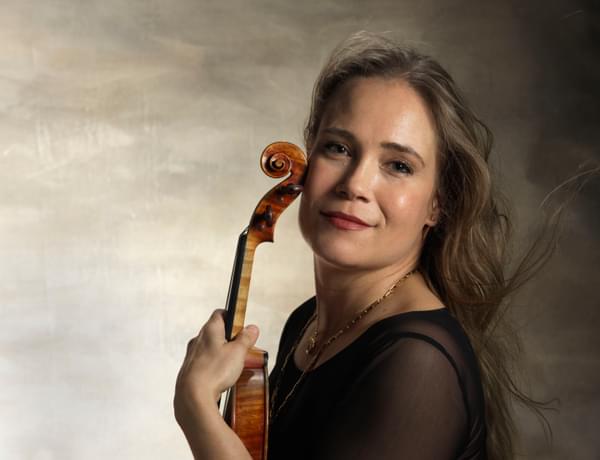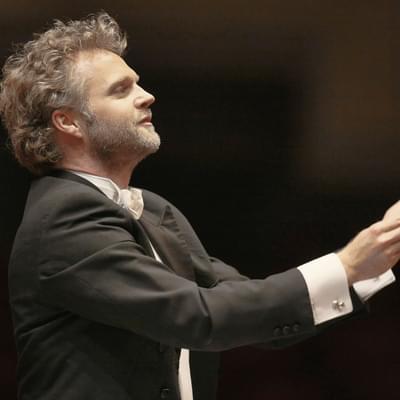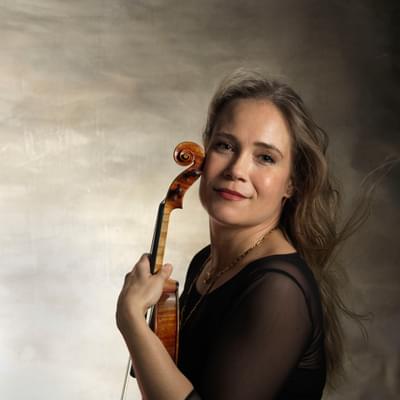Brahms 2

Full programme
- Strauss, Don Juan (17mins)
- Thomas Adès, Violin Concerto (Concentric Paths) (20mins)
- Brahms, Symphony No.2 (42mins)
Performers

Thomas Søndergård
Conductor
Leila Josefowicz
Violin
Introduction
I’m always fascinated by how musicians and audience members alike are moved by live performances – sometimes it’s the sheer power of the music, sometimes something more thoughtful, sometimes an expression of emotion, but it’s always about human experience, and at the core of that is something that binds us all together.
Tonight’s programme encompasses music that expresses a breadth and contrast of emotions – it was one of the programmes I saw in our season release that caught my eye for that reason. For me, the common thread is people, and our attempts to make sense of the world and our experiences in it.
All the incredible people that you see on stage before you make the CBSO what it is; one of the things I love about the orchestra is that nothing compares to the impact of being sat right in the middle of it when it’s in full flow, with all that glorious sound whirling around this beautiful hall.
We begin with Strauss’ depiction of Nikolaus Lenau’s “magic circle, immeasurably wide, of beautiful femininity” in the whirlwind of passion that is Don Juan (containing one of my top goosebump musical moments with the heroic horn section) and conclude our concert with the (mostly) sunny, serene pastoral second symphony by Brahms, these two pieces written just over ten years apart.
In the centre of it all is Adès’ violin concerto, a haunting search through the realms of possibility to find some sort of resolution. This is a fiendishly difficult piece for our soloist but with an emotional impact that lands.
There’s something very human about this programme, something that hopefully will resonate with all our lives in different ways; whether that’s in the sweep of the whirlwind of attraction, in thoughts clashing, overlapping and finding some resolution, or in the solace of nature when perhaps difficult things are rumbling in the background of life. I hope you find something here that moves you.
Lowri Porter
Section Leader Second Violin
Programme Notes
Strauss creates an exhilarating portrait of Don Juan’s wild life and dramatic death. Adès' Violin Concerto traces musical rings, paths and rounds through its three movements. Leila Josefowicz and Thomas Søndergård dance and whirl with the music. Brahms wrote to his publisher that for his Symphony No.2 he had ‘never written anything so sad’. His tongue, however, was firmly in his cheek as this is one of his most outrageously cheerful pieces.
Don Juan - tone poem after Nikolaus Lenau, Op.20
Richard Strauss (1864-1949)
A rocketing flurry, a cocksure fanfare – you don’t need to know the name of the piece to realise that this is going to be a swashbuckler. And what kind of 24-year old composer has the nerve to portray the great seducer Don Juan in music? Surely not that nice young Richard Strauss, son of a famous Munich horn player and such a polite young composer? Young Richard grew up terribly suddenly, and he did it with a brilliance, an impertinence, and a panache that were entirely his own. Don Juan was premiered on 11th November 1889 by the Weimar court orchestra. Someone asked Strauss whether he was a Wagnerian or a Brahmsian. "Neither" he replied "I’m a selfian".
Strauss took his version of Don Juan from a drama of 1851 by the German poet Nikolaus Lenau. Lenau's Juan lives fast and dies young, but there's some sensational living (and loving) to be done first. A solo violin introduces his first conquest but the swirling, swooning love music soon yields to the next call to action; and the adventures continue until stopped in their tracks by Juan's one true love - a poignant melody for solo oboe.
Juan hesitates, then rises to the challenge with a magnificent new theme: a ringing, virile call for all four horns. And yes - that's exactly what was on Strauss's mind. This is young man's music. (As Strauss himself told an orchestra that was about to play Don Juan: "Those of you who are married - play it as if you've just got engaged"). But even as a young man, the artist in Strauss sees further. Sated with life and overwhelmed by melancholy, Lenau’s hero discards his sword at the height of a duel. Strauss’s final bars – a sudden, chilling, fade to black – are the work of a realist, not an escapist.
Violin Concerto (Concentric Paths)
Thomas Adès (b.1971)
I. Rings
II. Paths
III. Rounds
In 1996, Sir Simon Rattle, the CBSO and Birmingham’s Feeney Trust backed a hunch about an unknown young composer. Thomas Adès was only 26 but Asyla, premiered at Symphony Hall on 1st October 1997, was an instant sensation: a symphony for a new Millennium, richly-imagined and powerfully assured. “Totally original, uncompromisingly serious, utterly of our time and a teasing, tingling delight to the ear. This is music that orchestras are going to want to play, and audiences to hear, again and again” predicted Andrew Clark of the Financial Times, with complete accuracy.
Since that warm night in Birmingham, 27 years ago, Thomas Adès has become a global phenomenon – one of the most admired (and most played) living composers, not just in Britain but in the world. Here in Birmingham we’ve naturally followed his career with excitement and interest, and in 2006, we were the first British orchestra to perform his violin concerto Concentric Paths (2005), less than a year after its premiere in the USA. Ades’s own description of the concerto is typically restrained, for such a colourful and imaginative work. “This concerto has three movements, like most, but it is really more of a triptych, as the middle one is the largest” he explains:
"It is the 'slow' movement, built from two large, and very many small, independent cycles, which overlap and clash, sometimes violently, in their motion towards resolution."
"The outer movements too are circular in design, the first fast, with sheets of unstable harmony in different orbits, the third playful, at ease, with stable cycles moving in harmony at different rates."
Well, that’s one way of putting it. One American critic, however, said that the concerto “tours the boundaries of madness, with ecstatic babblings, orchestral cataclysms, stammering brass, and limping dinosaur treads”. So which is it: orbits or dinosaurs? Adès would ask only that you listen to the music, and follow the path (concentric or otherwise) that your own ears, mind and heart create for you.
Symphony No.2 in D, Op.73
Johannes Brahms (1833-1897)
I. Allegro non troppo
II. Adagio non troppo
III. Allegretto grazioso (Quasi andantino)
IV. Allegro con spirito
Brahms spent two decades writing his First Symphony. As a young man, Schumann had hailed him as the heir to Beethoven - so Brahms, self-critical at the best of times, knew that he had a lot to live up to. It was finally premiered on 4th November 1876. And then, less than a year later, Brahms announced to his astonished friends that he'd finished another. So soon after the First, and written in a fraction of the time - what on earth could it be like? Brahms dropped a few hints shortly before its premiere on 30th December 1877. "Musicians here play my latest in black crape armbands because it sounds so mournful" he wrote not a friend, "and it'll be printed with a black border".
If you know the Symphony you'll already be smiling. For all his seriousness, Brahms loved a leg-pull. This new Symphony was the sunniest and most serene major work he'd ever put in front of an astonished public. The stormy-browed titan of the First Symphony had now, it seemed, made a Symphony of waltzes, lullabies and glowing colours. Everything about it breathed relaxation, and some listeners dubbed it Brahms' Pastoral symphony. He spotlights the rustic sounds of horns, clarinets and cellos, and includes a third movement whose lilting oboe solo sounds like a shepherd's pipe.
But this is definitely Brahms' Pastoral, not Beethoven's. Beethoven's is in F major - a clear, bright key, and his symphony is brisk and springlike. D major, Brahms' choice, is traditionally a mellow key of warmth and celebration - so, put one way, Brahms' symphony feels like a golden late-August afternoon against Beethoven's bright May morning. That could hardly be the whole story, of course - a composer who's just spent most of his adult life learning how to write a true classical symphony doesn't suddenly forget those lessons. Opening with a rumble in the basses and a tender horn call, it's a good few bars before the violins sail in with a serene, singing theme and the movement starts to stir. It feels like Brahms is simply gathering breath.
But listen carefully - the four low notes that are the very first things you hear appear again and again throughout the symphony, tying the argument together. The lovely melody for cellos and horns a few moments into the first movement might sound like the twin of Brahms' famous Lullaby; but it's also the "second subject" of this classically-structured movement. And the second movement, rich and dark, really is Brahms at his most eloquently serious. He knew that sunshine alone can express nothing without shade. Vintage wine from fine old kegs: this Adagio pours its wisdom sweet and clear.
But still - the Second Symphony really was the very last thing anyone expected from the composer of the First. Anyone, that is, except Brahms, who throughout his career followed passionate, hard-fought masterpieces with works that seemed the exact opposite. Few composers disciplined themselves as strictly as Brahms. So when we hear him indulging in long, gorgeous solos for his beloved horn and clarinet, letting fly as exuberantly as he does in the finale, and finally blazing exultantly away with the biggest brass section he ever used - well, it's hard not to feel he's earned the right. As his great supporter, the critic Eduard Hanslick put it: "The Second Symphony extends its warmth to connoisseurs and laymen alike. It belongs to all who long for good music, whether they understand the technicalities or not".
© Richard Bratby